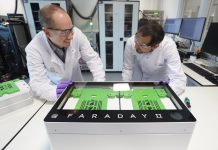
Restore has combined a grid scale battery with megawatts of industrial load and generation assets to deliver balancing services to European transmission system operators – and plans to replicate the model in the UK.
The Centrica-owned aggregator spoke today alongside project partners including Tesla, which provided the 18MW battery, at the launch of the Terhills project in eastern Belgium.
The virtual power plant will stack reserve and frequency service provision with trading on day ahead and intraday electricity markets.
Restore UK vice president Louis Burford said the model will be replicated in the UK with a project to be announced in the coming weeks, albeit on a smaller scale.
The company refers to its model as a ‘synthetic pool’. Burford said synthetic portfolios can unlock greater value from batteries by enabling other types of assets or load to deliver flexibility into fast response markets that they could not technically deliver by themselves.
Equally, he said it means less granular, or slower responding assets, can earn a share of higher value balancing services revenues by being pooled with batteries.
“By creating synthetic pools or portfolios, you reduce the technical requirements on individual assets that otherwise would not be able to participate [in certain balancing services],” Burford told The Energyst.
“By doing so you create value where it does not ordinarily exist. That is only achievable through synthetic portfolios.”
Burford added that bringing industrial loads into play also helps system operators, because load response has an effect on system inertia, which is dwindling as large thermal plant is displaced by smaller distributed generation.
The less inertia on transmission systems, the more volatile they become. Hence grid operators designing services that reward faster acting assets such as batteries.
By combining industrial loads and generation with batteries, Burford claimed grid operators can react to the symptoms of loss of inertia, as well as help address the cause. He also claimed costs to consumers will be lower, because fewer batteries are required on any given system, and revenues paid to flexibility providers higher, because they can help deliver greater services than the sum of their component parts.
Related stories:
Centrica acquires Restore for £62m
Demand-side response market faces ‘significant consolidation’
Restore signs 25MW demand turn up deal with National Grid
Battery storage to push frequency response revenues down STOR’s path?
Northern heat and powerhouse: Energy innovation puts Gateshead on the map
Centrica to use Gateshead’s 3MW battery for local and national balancing services
Follow us at @EnergystMedia. For regular bulletins, sign up for the free newsletter.




Large scale electric power storage with batteries is a game changer for electric power generation, however we need to be careful about the battery technology used, especially lithium batteries that have a finite working life. It is my understanding that recycling lithium costs about 3 times the cost of mining it and viable lithium deposits are only found in a few places on earth. Alternative electric power storage to lithium needs to be considered, such as redox flow batteries which have a much longer life than lithium, and storage via electrolysis to hydrogen is probably the future for hydrogen powered transport.